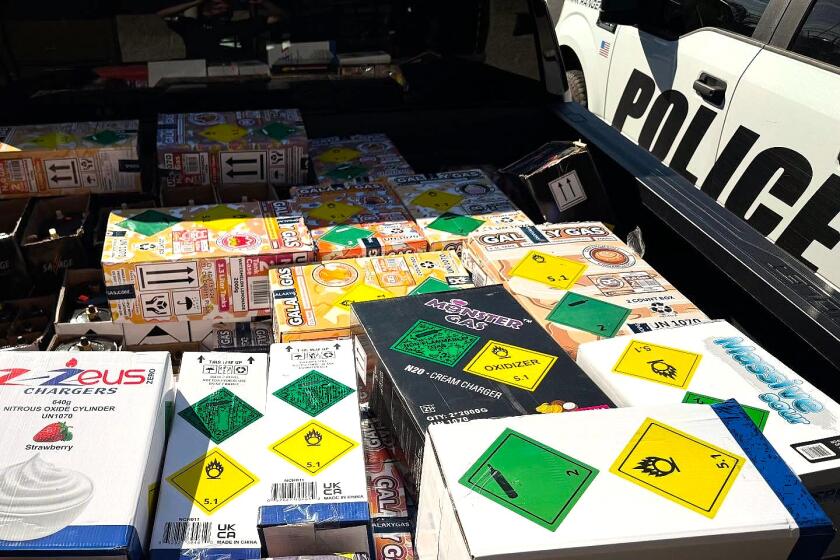THE COASTAL GARDENER:
- Share via
Tuesday at 4:30 in the morning in Newport Beach it started raining. For the next two and a half hours we got our first rain of the season. Hurray!
It wasn’t a lot — about three-tenths of an inch, but it’s a start.
Two hours later, at 6:30 a.m., I was on my way to work; the windshield wipers were on. As I sometimes do, I went for a detour through a couple of residential neighborhoods to look at the gardens. (I know I’m peculiar, but I like to explore unknown neighborhoods in search of interesting landscapes, unusual plants or creative designs. My 16-year-old daughter no longer wants to be in the car with Dad because of this unusual compulsion, but that’s another story.)
Rather than buzz down MacArthur Boulevard at 50 miles an hour, this wet, rainy morning I took a more leisurely route along San Miguel Drive.
Carefully navigating the slippery streets, I veered into the Harbor View neighborhood. For those of you not familiar with this area it is a stereotypical Newport Beach community; a collection of well-maintained, medium-age homes. The gardens are moderately sized, large compared to many newer developments and are nicely planted, albeit in a rather traditional and “safe” manner.
Remember, it was raining.
As I turned into the neighborhood I noticed an irrigation system in operation. That seemed odd. Then another. I decided to count, so as I drove down the first street I kept tally of how many sprinkler systems were on in the first 25 homes that I passed. Nine out of 25 were irrigating their gardens ... in the rain.
We can do better than that. Remember, we’re in a drought.
Consequently, as I do every year sometime in the fall, this is the week I suggest that we turn off our automatic sprinkler irrigation systems. To many homeowners this small electronic device on the wall of our garage is an intimidating slice of technology. A bit like the Black Box in an airplane, you know it’s there, but it’s best not to open it up. Who knows what might be inside.
Nonetheless, flip the latch and open the door. Depending upon your model you will see a dial, sometimes two. One of the dials will have a setting labeled “Off.” Turn the dial to this and for the next four to five months leave it there. About March of next year, when the weather begins to warm up again, put the dial back to “Auto” or “Run.” That’s it. You’ve just made a significant reduction in your water use.
Certainly, there will be times between now and March when you will need to water your garden. But, unlike the warm, consistently dry months of summer, this time of the year there is no way to know which days should be watering days. Until spring, the weather is far too variable for a “timer” to water correctly.
Shut the system off completely and when a hot dry period occurs, just turn the dial to “Manual” for a complete irrigation. You will find that your plants will be happier as well.
I have asserted for many years that in Southern California we waste more water during the cool months than in the warm months.
Confusion may happen because many still believe that somehow there is more water available to us during the winter than there is in the summer. This is a dangerous misconception that leads to serious water waste. In Southern California, all of our water is stored water. In other words, for us there is no more water available in the winter than in the summer. Even though it’s raining outside, the water coming through your faucet is the same water that will come through next summer.
Please, use water wisely. Find your irrigation clock and turn it to “Off” and use the “Manual” feature during the next few months. Your plants and others will thank you.
ASK RON
Question: Where could I see Buffalo grass being used in a landscape? Would you recommend it for a front yard and sidewalk to curb area? Which strain? Thank you.
Meg
Corona del Mar
Answer: Meg, you’ve done your research. Buffalo grass is one of the “new” lawn grasses just beginning to enter the local market. Its incredible drought tolerance and requirement of only a handful of mowings each year make it a promising alternative as a turf grass. However, this is a warm-season grass and does have a winter dormancy period, similar to hybrid bermudagrass. Late next spring or early summer would be the time to plant the plugs. For local gardens, the best variety is called “Verde” and was patented by the University of California in 2003. I know of several private gardens with Buffalo grass, but not a public one yet. If you can wait until next year we will be converting a portion of our landscape at Roger’s Gardens to “Verde” Buffalo grass.
ASK RON your toughest gardening questions, and the expert nursery staff at Roger’s Gardens will come up with an answer. Please include your name, phone number and city, and limit queries to 30 words or fewer. E-mail [email protected], or write to Plant Talk at Roger’s Gardens, 2301 San Joaquin Hills Road, Corona del Mar, CA 92625.
RON VANDERHOFF is the Nursery Manager at Roger’s Gardens, Corona del Mar.
All the latest on Orange County from Orange County.
Get our free TimesOC newsletter.
You may occasionally receive promotional content from the Daily Pilot.



